How wonderful it is that the Feast of the Immaculate Conception of Mary always falls within the start of Advent. Thus, in the very season during which we wait with longing for the Word made flesh to come to us as Emmanu-el (God-with-us), we are invited to consider how deeply planned, how “not-random” is his coming, by pondering his Mother Mary, and the very fact of her.
“Without God’s Son, nothing could exist; without Mary’s son, nothing could be redeemed,” declared St. Anselm in a sermon, also noting that God is “Father” of the created world and Mary the “Mother” of the world recreated in Christ. Anselm completes his thought by echoing the words of the Archangel Gabriel to Mary: “Truly the Lord is with you, to whom the Lord granted that all nature should owe as much to you as to himself.”
It’s a lot to take in. Mary’s own conception had itself been something pre-ordained by God as necessary within the pageant and process of our salvation—a moment of creation untainted by the brokenness of original sin, which had accompanied every human conception since the first sin of Eden.
From the very beginnings of her existence within the womb of Anne, her mother, the body and soul of Mary were created as the imperatively immaculate vessel required for the containment and growth of the Incarnation of the All Holy. Mary was created with the graces that would render her a fit Ark for the New Covenant, and not only for the time of Jesus’ gestation within her womb but throughout her entire life.
This is a fact the Church might appreciate even more today than at any time previous, thanks to science and the discovery of microchimerism.
We have learned that within the process of microchimerism, every baby conceived by a woman leaves within her a microscopic bit of his or her cellular being, even if gestation is interrupted, and remains with her forever.
Mary, then, was indeed a tabernacle for the Divinity—not for a limited time but for all of her life, as these invisible but real reserves of the Christ remained within her.
Knowing this only reinforces how necessary, how profoundly sensible and reasonable-in-faith is the dogma of the Immaculate Conception, which was deduced long before a time of microscopic discovery. It makes perfect sense that the God who is all good is also completely pure; therefore, the vessel in which he would reside and be made manifest need also be pure, or it could never have been able to sustain all of the light, all of the holiness, all of that power extant within the All-in-All.
Were Mary not be-graced by God for that very purpose of holy containment and development, she would have been crumbled into dust by the immensity of it.
And this relates directly to the Assumption of Mary as well. In the Psalms we read: “You will not suffer your beloved to undergo corruption” (Psalm 16:10). Christ’s divine body did not undergo corruption, but ascended into heaven; it follows that his mother’s body, which contained the cellular components of that divinity—and a particle of God is God, entire—would not be permitted to undergo corruption either.
It could not be otherwise. The God particle, commingled with humanity, necessarily preserves humanity and calls it to himself. This is Incarnational. It is Eucharistic, from the beginning.
It is our life, conceived in light.
And yes, a lot to take in. It’s a lot to take in that God had so thoroughly planned, in the fullness of time, to draw all things to himself through Christ Jesus (Ephesians 1:10), and that we can see the reality of his plans in the Immaculate Conception of Mary and in her life.
It’s also a lot to take in, and something we rarely consider (even when we say, “To Jesus, through Mary”): that Christ’s Body and his Blood are Mary’s as well—that the foundational materials of our Holy Eucharist come to us through Mary. Without Mary’s body, Emmanu-el would not have been with us, and so it makes perfect sense that—as Ark and nurturing catalyst for the New Creation—her body and blood (and her generous, pristine soul) would be preserved of defect, and rendered “full of grace.”
As St. John Vianney preached, “The Father takes pleasure in looking upon the heart of the most holy Virgin Mary, as the masterpiece of his hands. . . . The Son takes pleasure in it as the heart of His Mother, the source from which He drew the blood that . . . ransomed us.”
To Jesus, through Mary, indeed. Those non-Catholics who misunderstand Mariology and assert that Catholics pay her too much homage are missing the point of the essential mission to which she gave her consent: to provide the profoundly pure flesh and blood by which the Savior would eventually—and throughout the ages—feed us and heal us with the super-substantial “daily bread” of the Eucharist. The gift rendered Holy through Christ’s own divinity and called forth by his Bride, the Church.
Seen in that light, how could we ever do Mary homage enough for her fiat, and her lifelong example of how to cooperate with grace?
How could we not, especially in Advent, want to ask the prayers of one so beloved of the Incarnate Word, an intercessor who troubled Christ Jesus for something as temporal and passing as wine at a wedding, and to whom we can speak so simply?
Especially in this month, let us say each day, with perfect confidence in this “Mother of the world, recreated in Christ”: O Mary, conceived without sin, pray for us who have recourse to thee!
